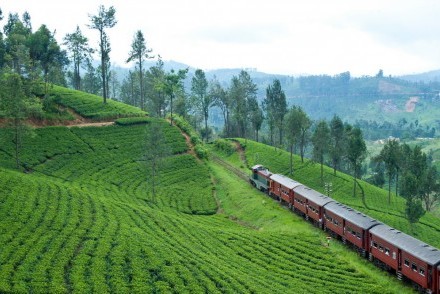TikaWeeks #14/2023: Sri Lanka update
Posted by John on 3rd April 2023

Trains are now part of everyday life in Sri Lanka but the railway has had a tumultuous time ever since British colonists first explored its possibilities for transporting coffee, coconut, rubber and tea from the plantations around Kandy to Colombo on the coast for export back in 1842. Today the railways are fundamental to the public transport network around the island as well as a popular tourist attraction. Here are five of the best rail journeys in Sri Lanka.
For more than a century the railways rarely carried a single passenger. However, when Sri Lanka gained independence in 1948 train use rose dramatically for a short period until the economy changed from agriculture to industry, and rails were suddenly eclipsed by roads. For sixty years, the railways fell into decline - diesel locomotives didn’t replace the old steam trains until the 1970s. But in 2010, a major reinvigoration project was launched and the Sri Lankan rail network enjoyed a rebirth.
A recent Wanderlust magazine article explores Sri Lanka’s 5 best rail routes:
- Kandy to Badulla
- Nuwara Eliya to Ella
- Colombo to Kandy
- Colombo to Galle
- Anuradhapura to Jaffna
The Pekoe Trail – Stage 4: Thawalanthenna to Kumbaloluwa
A moderately challenging stage of The Pekoe Trail, this quiet 10.9-km section should take around 3.5 hours to complete without encountering too many other people.
The first few kilometres of this trail go through the residential areas of two towns, Thawalanthenna and New Kotmale, before narrowing onto smaller village roads surrounded by local housing and the occasional rice paddy field on the descent towards the Ramboda Oya at the 3.7 km point, where a hydroelectric plant is located.
On crossing the Ramboda Oya, there is a signboard to a school a few hundred metres above the village road at 5.2 km where the trail climbs into the private Greenfield Estate following a permissive path through a line of mango trees and on into the residential part of the estate. At the 6.7-km point, the trail levels out and Kotmale reservoir may be clearly seen below. This large hydroelectric and irrigation dam, built between 1979 and 1985, feeds the second largest hydroelectric power station in Sri Lanka. Kotmale Mahaweli Maha Seya stupa, at the far end of the reservoir and standing 84 metres high and 61 metres across, serves as a reminder of the 18 shrines and temples that were submerged during the construction of Kotmale reservoir.
According to legend, the ancient kings of the Gampola Kingdom used to hide among the inaccessible mountains around Pussellawa and Kotmale when threatened by enemies. The Sinhalese prince Dutugamunu is said to have taken refuge in Kotmale to escape the wrath of his father, King Kavantissa. Kotmale is also where the Kandyan kings hid the sacred tooth relic during periods of political instability, the last occasion during the British occupation in 1815.
The trail now begins a gradual ascent on what is clearly an abandoned old British-engineered road. Though in disrepair and much neglected with overgrown margins, the road is the perfect gradient and width for bullock carts of the era. After a few hundred metres, the old track becomes a modern tarmac road at the 8.3-km point, where the remains of an old tea factory give way to some of the best views anywhere in the tea country.
Continuing down 'the road to nowhere' for approximately 2.5 km to the junction marks the end of the stage.
Categories: News, Sightseeing, Sri Lanka, Travel tips
« All articles




